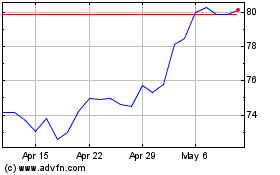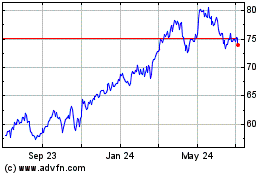Fed Outlines New Requirements for Insurance Firms -- Update
June 03 2016 - 3:38PM
Dow Jones News
By Ryan Tracy and Leslie Scism
WASHINGTON -- The Federal Reserve took a step toward imposing
tougher capital requirements on insurers tagged for heightened
oversight, sketching out proposals that companies can now respond
to after years of uncertainty about the process.
The Fed's proposals, however, leave key details to be determined
later, such as specific numerical capital requirements for large
insurers Prudential Financial Inc. and American International Group
Inc. U.S. regulators have tagged those two companies "systemic,"
and as such they face tougher rules than other insurers.
The proposals are set for a vote by the central bank's governing
board later Friday, after which the industry would have a chance to
comment on them.
One proposal, outlining capital rules for insurance firms under
the Fed's purview, suggests a tougher set of rules for Prudential
and AIG than for 12 insurance companies that own banks, including
State Farm Mutual Automobile Insurance Co. and Nationwide Mutual
Insurance Co. The Fed is asking for public comment on the capital
concept, after which it would publish a draft rule.
Separately, the Fed is also set to propose draft risk-management
and liquidity rules for Prudential and AIG, including requiring
that they maintain enough safe assets to cover cash flows for 90
days and that they run "stress tests" ensuring they can meet their
cash flow needs.
Those standards would likely take effect before the capital
rules, but the Fed expects that the firms will be able to meet the
new liquidity rules relatively easily, a Fed official told
reporters on a conference call, calling them existing best
practices for many firms.
"I believe this proposal is an important step toward capital
standards that are both appropriate for our supervised insurance
firms and that enhance the resiliency and stability of our
financial system," Fed Chairwoman Janet Yellen said.
Under the 2010 Dodd-Frank law, the Fed has authority over large
insurance firms with assets that represent about a quarter of the
U.S. insurance industry, which has mostly been state-regulated over
the years. The insurers have been awaiting the Fed's rules since
the law was passed, and the industry and its state regulators have
been pressing the Fed to tailor rules to reflect differences
between the operations of insurance companies and the banks the Fed
usually regulates.
The Fed's decision to issue a "concept" of the rules before
writing a more specific draft is both good news and a frustrating
development for insurers. The good news is that the Fed is being
thoughtful in taking on regulation of an industry it hasn't
historically overseen and wanting as much feedback as possible
before completing the rules. But it means insurance-industry
managers will continue making operational moves without knowing all
the important details that will apply in the future.
Fed officials said they are taking a "tiered" approach to
capital rules. For the 12 insurance companies not labeled systemic,
the Fed "would literally build on the requirements placed" on the
units by their existing regulators, Fed governor Daniel Tarullo
said.
That approach seems to address criticism that the Fed was
reinventing the wheel, when state insurance departments already
oversee the nation's insurance industry. But the central bank said
it could also require additional capital at those 12 firms to
address "financial stability" concerns that aren't contemplated by
state rules. In general, the Fed said, its rules would impose a
lower regulatory burden on those firms compared to Prudential and
AIG
For AIG and Prudential, whose "systemically important" label
means regulators think they could harm the broader financial system
if they were to collapse, the concept is to "create risk categories
for assets and liabilities across the holding company" for which
additional capital would be required, Mr. Tarullo said. The Fed
didn't specify the categories and asked for public input on what
they should be.
The rules have been years in the making, and already have had
important ramifications.
Earlier this year, AIG gave board seats to a top lieutenant to
activist investor Carl Icahn as well as to hedge-fund manager John
Paulson, after their calls for a breakup to get out from under Fed
regulation. The New York company is in midst of aggressive
cost-cutting, and divestitures of some assets or even businesses is
expected.
MetLife Inc., which successfully overturned its "systemically
important" label in court but could be redesignated if the
government wins its appeal, in January said it would jettison a
chunk of its life-insurance operations, for both strategic and
regulatory reasons.
Write to Ryan Tracy at ryan.tracy@wsj.com and Leslie Scism at
leslie.scism@wsj.com
(END) Dow Jones Newswires
June 03, 2016 15:23 ET (19:23 GMT)
Copyright (c) 2016 Dow Jones & Company, Inc.
American (NYSE:AIG)
Historical Stock Chart
From Mar 2024 to Apr 2024

American (NYSE:AIG)
Historical Stock Chart
From Apr 2023 to Apr 2024
